LINCOLN MKZ 2010 Owners Manual
Manufacturer: LINCOLN, Model Year: 2010, Model line: MKZ, Model: LINCOLN MKZ 2010Pages: 318, PDF Size: 2.22 MB
Page 221 of 318
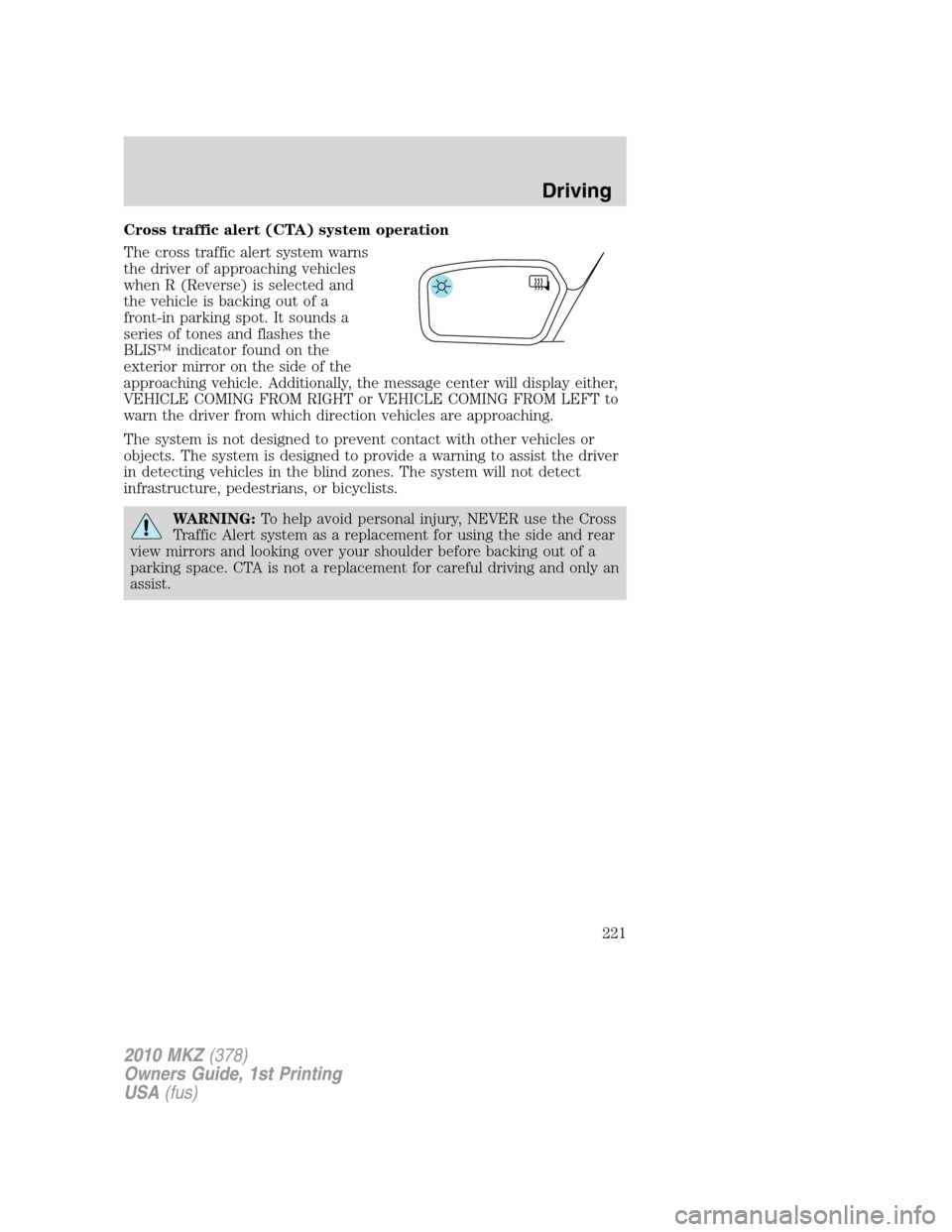
Cross traffic alert (CTA) system operation
The cross traffic alert system warns
the driver of approaching vehicles
when R (Reverse) is selected and
the vehicle is backing out of a
front-in parking spot. It sounds a
series of tones and flashes the
BLIS™ indicator found on the
exterior mirror on the side of the
approaching vehicle. Additionally, the message center will display either,
VEHICLE COMING FROM RIGHT or VEHICLE COMING FROM LEFT to
warn the driver from which direction vehicles are approaching.
The system is not designed to prevent contact with other vehicles or
objects. The system is designed to provide a warning to assist the driver
in detecting vehicles in the blind zones. The system will not detect
infrastructure, pedestrians, or bicyclists.
WARNING:To help avoid personal injury, NEVER use the Cross
Traffic Alert system as a replacement for using the side and rear
view mirrors and looking over your shoulder before backing out of a
parking space. CTA is not a replacement for careful driving and only an
assist.
2010 MKZ(378)
Owners Guide, 1st Printing
USA(fus)
Driving
221
Page 222 of 318
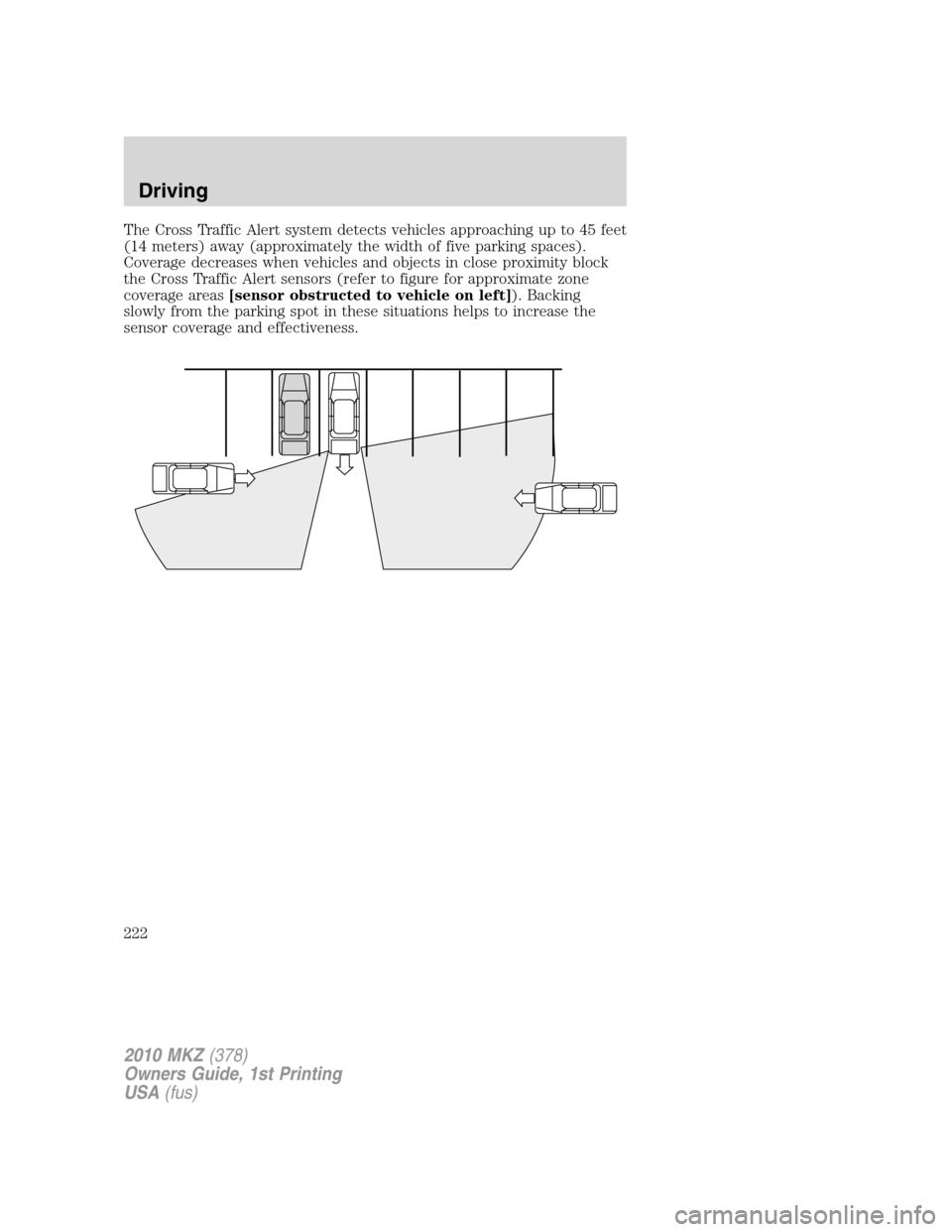
The Cross Traffic Alert system detects vehicles approaching up to 45 feet
(14 meters) away (approximately the width of five parking spaces).
Coverage decreases when vehicles and objects in close proximity block
the Cross Traffic Alert sensors (refer to figure for approximate zone
coverage areas[sensor obstructed to vehicle on left]). Backing
slowly from the parking spot in these situations helps to increase the
sensor coverage and effectiveness.
2010 MKZ(378)
Owners Guide, 1st Printing
USA(fus)
Driving
222
Page 223 of 318
![LINCOLN MKZ 2010 Owners Manual Cross Traffic coverage also decreases when parking at shallow angles
(refer to figure for approximate zone coverage areas[sensor
obstructed to vehicle on left]).
CTA Detection Limitations:Due to the n LINCOLN MKZ 2010 Owners Manual Cross Traffic coverage also decreases when parking at shallow angles
(refer to figure for approximate zone coverage areas[sensor
obstructed to vehicle on left]).
CTA Detection Limitations:Due to the n](/img/15/6972/w960_6972-222.png)
Cross Traffic coverage also decreases when parking at shallow angles
(refer to figure for approximate zone coverage areas[sensor
obstructed to vehicle on left]).
CTA Detection Limitations:Due to the nature of radar technology,
there may be certain instances where vehicles entering and exiting the
blind spot zones may not be detected. Below is a list of circumstances
that may cause non detection:
•Debris build up on the rear quarter panel fascias
•The rear quarter panel radar beams are obstructed or partially
obstructed by an adjacently parked vehicle or object.
•Approaching vehicles passing at speeds greater than 15 mph
(24 km/h).
•Severe weather conditions
•Driving in reverse faster than 3 mph (5 km/h).
•Backing out of an angled parking spot.
CTA and Reverse Sensing System (RSS) interaction
CTA works along with the Reverse Sensing System (RSS) (if equipped).
Become familiar with the warning tones of both systems.
2010 MKZ(378)
Owners Guide, 1st Printing
USA(fus)
Driving
223
Page 224 of 318
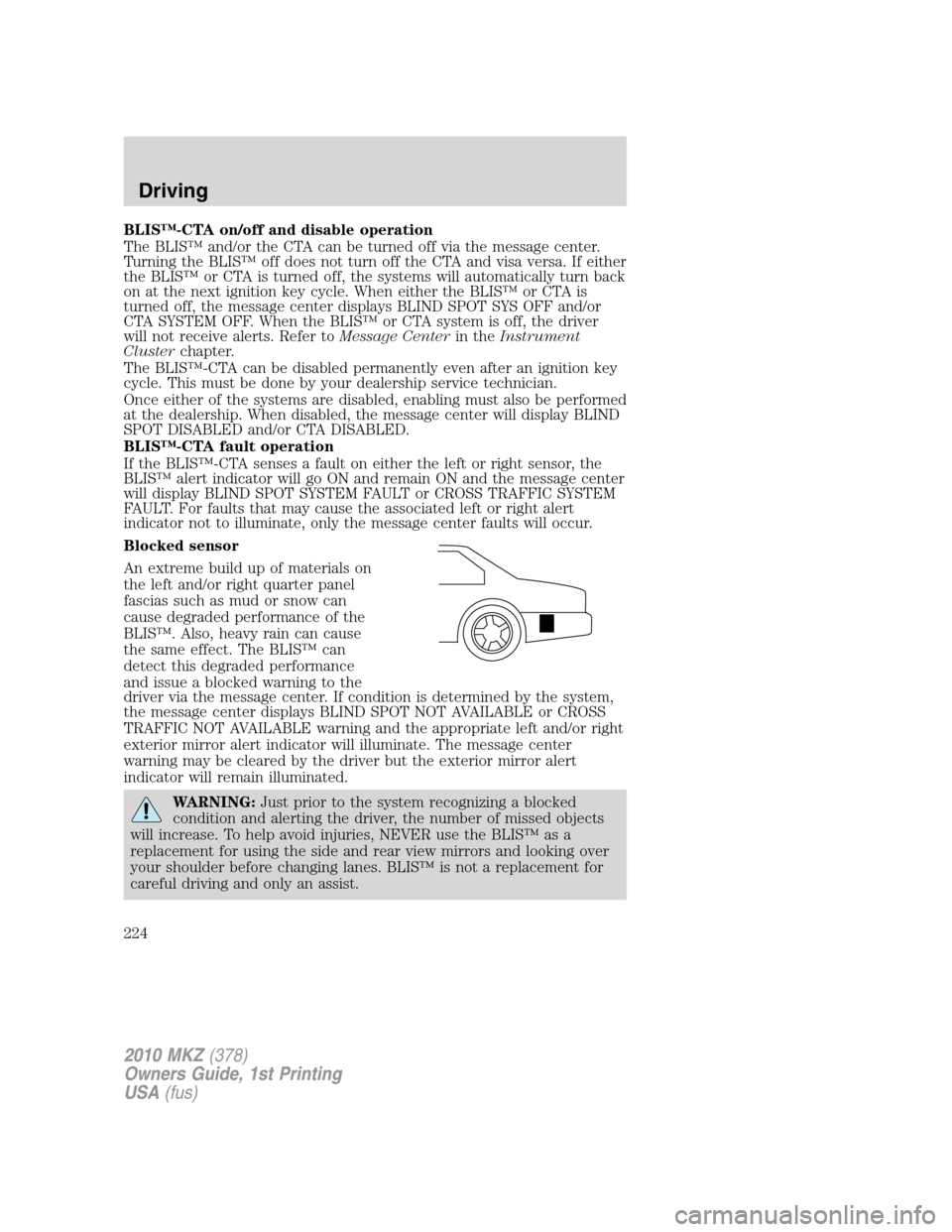
BLIS™-CTA on/off and disable operation
The BLIS™ and/or the CTA can be turned off via the message center.
Turning the BLIS™ off does not turn off the CTA and visa versa. If either
the BLIS™ or CTA is turned off, the systems will automatically turn back
on at the next ignition key cycle. When either the BLIS™ or CTA is
turned off, the message center displays BLIND SPOT SYS OFF and/or
CTA SYSTEM OFF. When the BLIS™ or CTA system is off, the driver
will not receive alerts. Refer toMessage Centerin theInstrument
Clusterchapter.
The BLIS™-CTA can be disabled permanently even after an ignition key
cycle. This must be done by your dealership service technician.
Once either of the systems are disabled, enabling must also be performed
at the dealership. When disabled, the message center will display BLIND
SPOT DISABLED and/or CTA DISABLED.
BLIS™-CTA fault operation
If the BLIS™-CTA senses a fault on either the left or right sensor, the
BLIS™ alert indicator will go ON and remain ON and the message center
will display BLIND SPOT SYSTEM FAULT or CROSS TRAFFIC SYSTEM
FAULT. For faults that may cause the associated left or right alert
indicator not to illuminate, only the message center faults will occur.
Blocked sensor
An extreme build up of materials on
the left and/or right quarter panel
fascias such as mud or snow can
cause degraded performance of the
BLIS™. Also, heavy rain can cause
the same effect. The BLIS™ can
detect this degraded performance
and issue a blocked warning to the
driver via the message center. If condition is determined by the system,
the message center displays BLIND SPOT NOT AVAILABLE or CROSS
TRAFFIC NOT AVAILABLE warning and the appropriate left and/or right
exterior mirror alert indicator will illuminate. The message center
warning may be cleared by the driver but the exterior mirror alert
indicator will remain illuminated.
WARNING:Just prior to the system recognizing a blocked
condition and alerting the driver, the number of missed objects
will increase. To help avoid injuries, NEVER use the BLIS™ as a
replacement for using the side and rear view mirrors and looking over
your shoulder before changing lanes. BLIS™ is not a replacement for
careful driving and only an assist.
2010 MKZ(378)
Owners Guide, 1st Printing
USA(fus)
Driving
224
Page 225 of 318

Once blockage is removed, the system will require some driving time and
detection of at least two vehicle object prior to realizing it is unblocked,
or the driver can cycle the ignition key. If blocked and the ignition key is
cycled, the system resets to unblocked. If however blockage is still
present after the key cycle, the system will sense again that it is blocked
after driving in traffic.
The following table lists possible causes and actions for this message
being displayed:
The surface of the left or right
radar is dirty or obstructed in
some wayClean the fascia area in front of
the radar, either left or right side,
or remove obstruction.
The surface of the left or right
radar is not dirty or obstructedDrive normally in traffic for a few
minutes to allow the radar to
detect that it is no longer blocked.
Note, the vehicle must be in D
(Drive) and a few vehicles must
pass so that the BLIS™ can clear a
blocked state.
Heavy rainfall or heavy snowfall is
interfering with the radar signalsNo action required by the driver.
The system will automatically go
unblocked once the
rainfall/snowfall rate decreases or
stops. Do not use BLIS™-CTA in
heavy rainfall or heavy snowfall.
Trailer tow false alerts
When towing a trailer the left and right sensor may detect the trailer
thus causing a false alert. It may be desirable to turn the BLIS™ system
off if the false alerts become annoying.
Day and night brightness
The BLIS™-CTA amber alert will automatically dim when the headlamp
switch is in PARK, ON, or AUTO ON and night time darkness has been
detected by the sun sensor.
2010 MKZ(378)
Owners Guide, 1st Printing
USA(fus)
Driving
225
Page 226 of 318
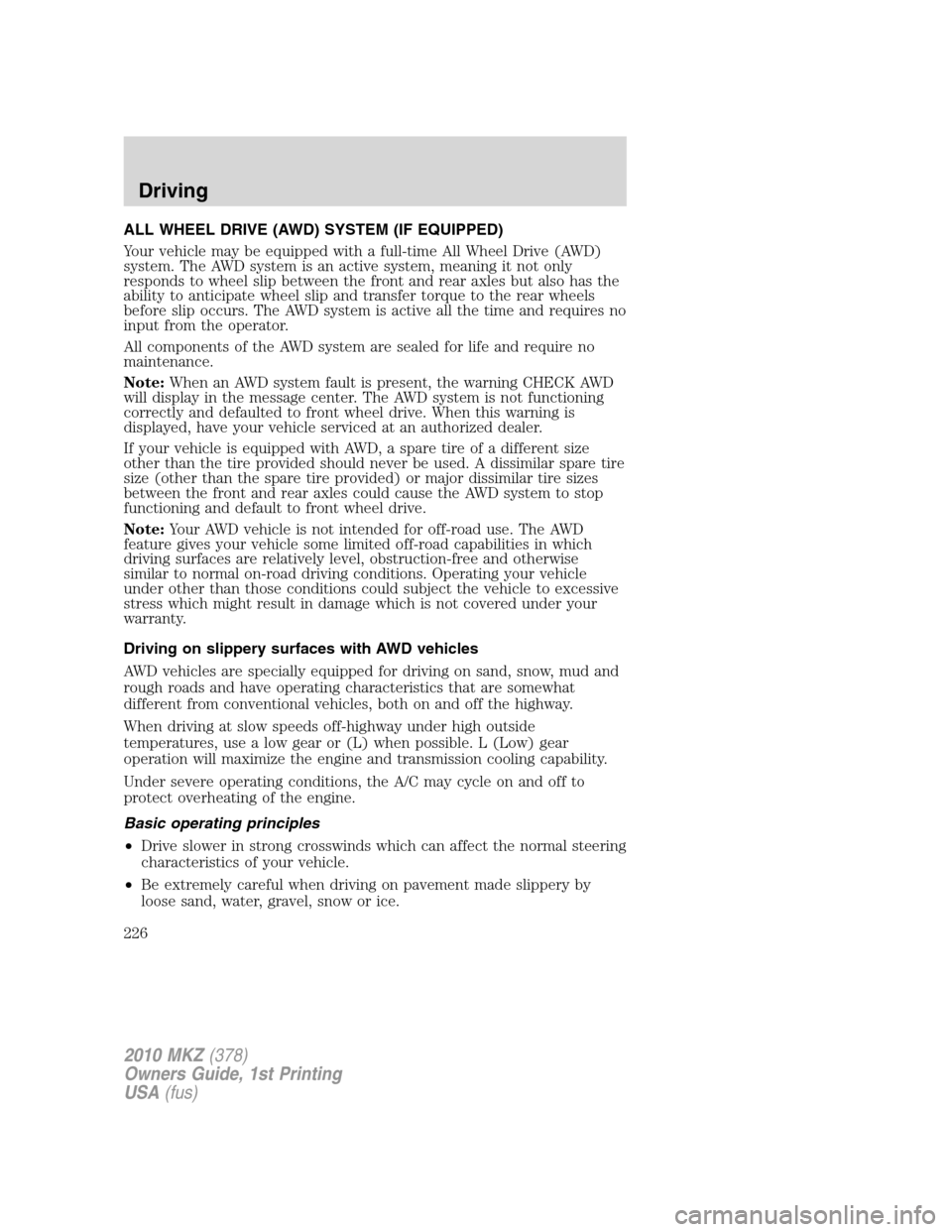
ALL WHEEL DRIVE (AWD) SYSTEM (IF EQUIPPED)
Your vehicle may be equipped with a full-time All Wheel Drive (AWD)
system. The AWD system is an active system, meaning it not only
responds to wheel slip between the front and rear axles but also has the
ability to anticipate wheel slip and transfer torque to the rear wheels
before slip occurs. The AWD system is active all the time and requires no
input from the operator.
All components of the AWD system are sealed for life and require no
maintenance.
Note:When an AWD system fault is present, the warning CHECK AWD
will display in the message center. The AWD system is not functioning
correctly and defaulted to front wheel drive. When this warning is
displayed, have your vehicle serviced at an authorized dealer.
If your vehicle is equipped with AWD, a spare tire of a different size
other than the tire provided should never be used. A dissimilar spare tire
size (other than the spare tire provided) or major dissimilar tire sizes
between the front and rear axles could cause the AWD system to stop
functioning and default to front wheel drive.
Note:Your AWD vehicle is not intended for off-road use. The AWD
feature gives your vehicle some limited off-road capabilities in which
driving surfaces are relatively level, obstruction-free and otherwise
similar to normal on-road driving conditions. Operating your vehicle
under other than those conditions could subject the vehicle to excessive
stress which might result in damage which is not covered under your
warranty.
Driving on slippery surfaces with AWD vehicles
AWD vehicles are specially equipped for driving on sand, snow, mud and
rough roads and have operating characteristics that are somewhat
different from conventional vehicles, both on and off the highway.
When driving at slow speeds off-highway under high outside
temperatures, use a low gear or (L) when possible. L (Low) gear
operation will maximize the engine and transmission cooling capability.
Under severe operating conditions, the A/C may cycle on and off to
protect overheating of the engine.
Basic operating principles
•Drive slower in strong crosswinds which can affect the normal steering
characteristics of your vehicle.
•Be extremely careful when driving on pavement made slippery by
loose sand, water, gravel, snow or ice.
2010 MKZ(378)
Owners Guide, 1st Printing
USA(fus)
Driving
226
Page 227 of 318
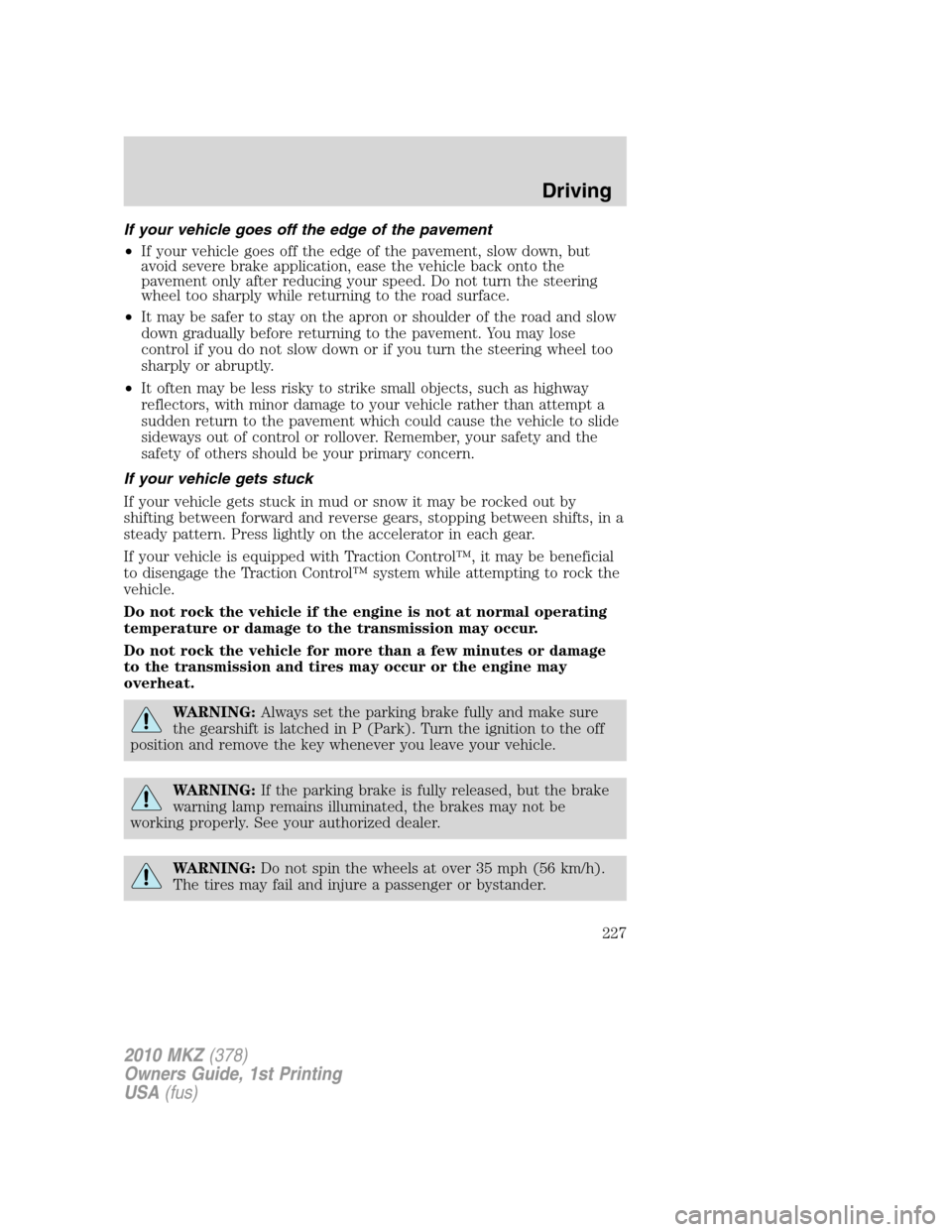
If your vehicle goes off the edge of the pavement
•If your vehicle goes off the edge of the pavement, slow down, but
avoid severe brake application, ease the vehicle back onto the
pavement only after reducing your speed. Do not turn the steering
wheel too sharply while returning to the road surface.
•It may be safer to stay on the apron or shoulder of the road and slow
down gradually before returning to the pavement. You may lose
control if you do not slow down or if you turn the steering wheel too
sharply or abruptly.
•It often may be less risky to strike small objects, such as highway
reflectors, with minor damage to your vehicle rather than attempt a
sudden return to the pavement which could cause the vehicle to slide
sideways out of control or rollover. Remember, your safety and the
safety of others should be your primary concern.
If your vehicle gets stuck
If your vehicle gets stuck in mud or snow it may be rocked out by
shifting between forward and reverse gears, stopping between shifts, in a
steady pattern. Press lightly on the accelerator in each gear.
If your vehicle is equipped with Traction Control™, it may be beneficial
to disengage the Traction Control™ system while attempting to rock the
vehicle.
Do not rock the vehicle if the engine is not at normal operating
temperature or damage to the transmission may occur.
Do not rock the vehicle for more than a few minutes or damage
to the transmission and tires may occur or the engine may
overheat.
WARNING:Always set the parking brake fully and make sure
the gearshift is latched in P (Park). Turn the ignition to the off
position and remove the key whenever you leave your vehicle.
WARNING:If the parking brake is fully released, but the brake
warning lamp remains illuminated, the brakes may not be
working properly. See your authorized dealer.
WARNING:Do not spin the wheels at over 35 mph (56 km/h).
The tires may fail and injure a passenger or bystander.
2010 MKZ(378)
Owners Guide, 1st Printing
USA(fus)
Driving
227
Page 228 of 318
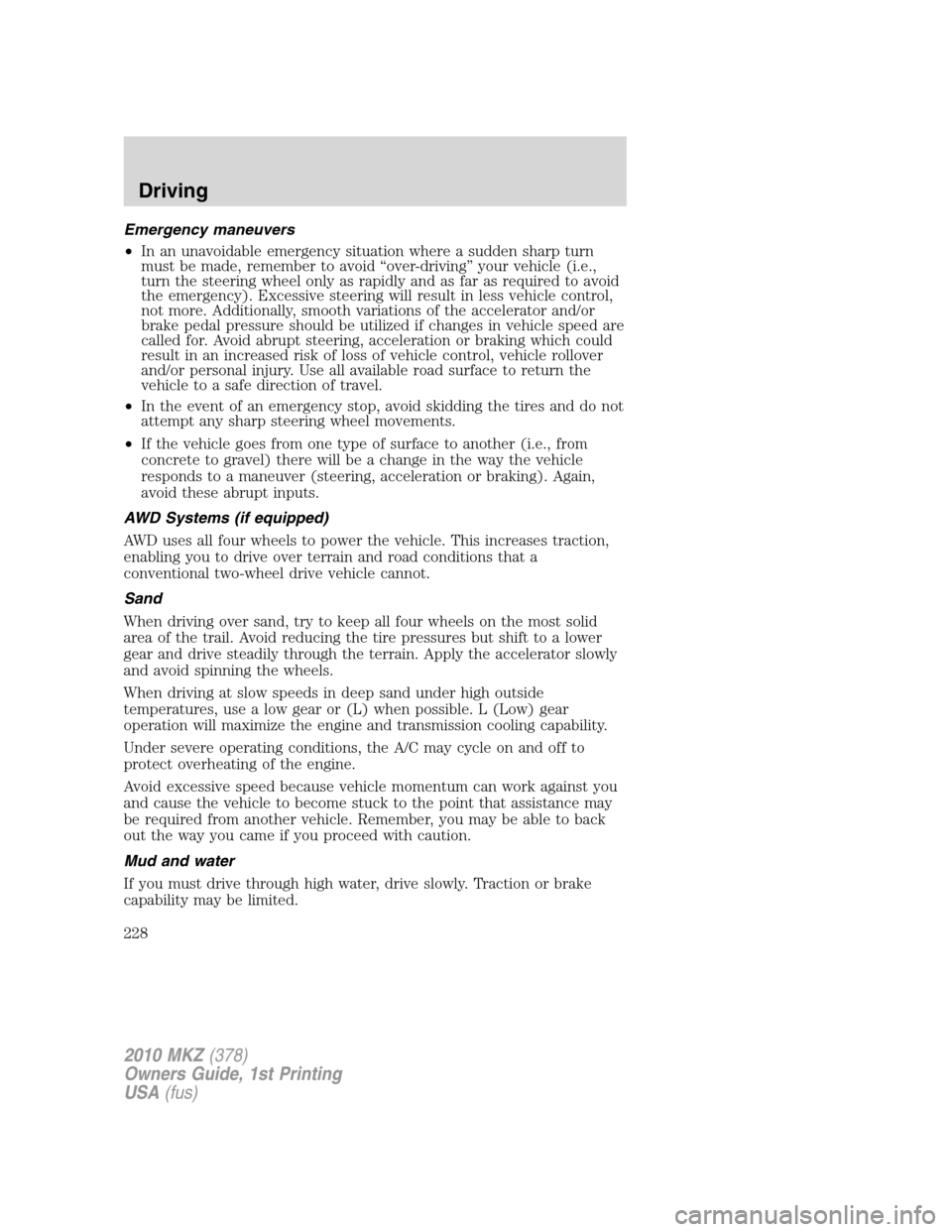
Emergency maneuvers
•In an unavoidable emergency situation where a sudden sharp turn
must be made, remember to avoid “over-driving” your vehicle (i.e.,
turn the steering wheel only as rapidly and as far as required to avoid
the emergency). Excessive steering will result in less vehicle control,
not more. Additionally, smooth variations of the accelerator and/or
brake pedal pressure should be utilized if changes in vehicle speed are
called for. Avoid abrupt steering, acceleration or braking which could
result in an increased risk of loss of vehicle control, vehicle rollover
and/or personal injury. Use all available road surface to return the
vehicle to a safe direction of travel.
•In the event of an emergency stop, avoid skidding the tires and do not
attempt any sharp steering wheel movements.
•If the vehicle goes from one type of surface to another (i.e., from
concrete to gravel) there will be a change in the way the vehicle
responds to a maneuver (steering, acceleration or braking). Again,
avoid these abrupt inputs.
AWD Systems (if equipped)
AWD uses all four wheels to power the vehicle. This increases traction,
enabling you to drive over terrain and road conditions that a
conventional two-wheel drive vehicle cannot.
Sand
When driving over sand, try to keep all four wheels on the most solid
area of the trail. Avoid reducing the tire pressures but shift to a lower
gear and drive steadily through the terrain. Apply the accelerator slowly
and avoid spinning the wheels.
When driving at slow speeds in deep sand under high outside
temperatures, use a low gear or (L) when possible. L (Low) gear
operation will maximize the engine and transmission cooling capability.
Under severe operating conditions, the A/C may cycle on and off to
protect overheating of the engine.
Avoid excessive speed because vehicle momentum can work against you
and cause the vehicle to become stuck to the point that assistance may
be required from another vehicle. Remember, you may be able to back
out the way you came if you proceed with caution.
Mud and water
If you must drive through high water, drive slowly. Traction or brake
capability may be limited.
2010 MKZ(378)
Owners Guide, 1st Printing
USA(fus)
Driving
228
Page 229 of 318
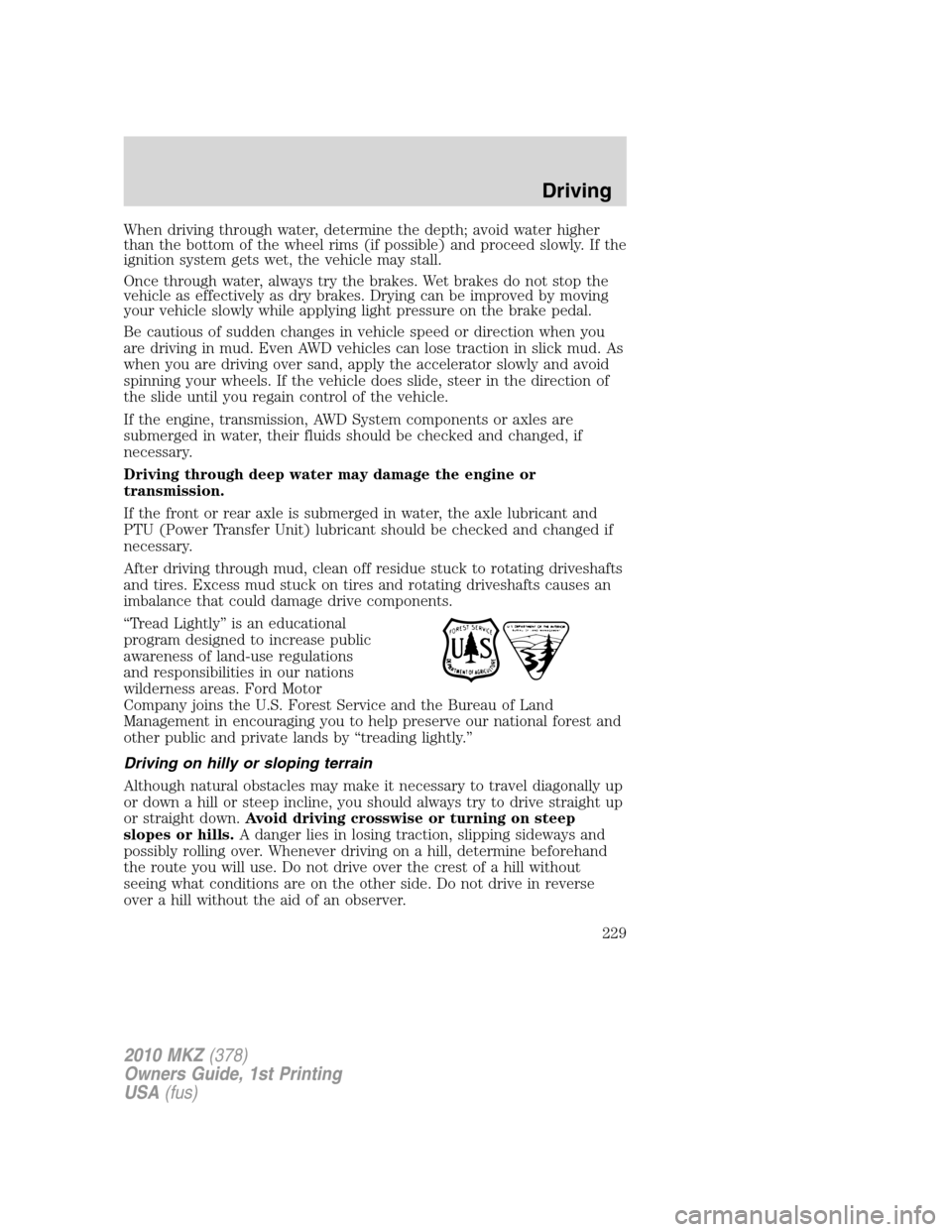
When driving through water, determine the depth; avoid water higher
than the bottom of the wheel rims (if possible) and proceed slowly. If the
ignition system gets wet, the vehicle may stall.
Once through water, always try the brakes. Wet brakes do not stop the
vehicle as effectively as dry brakes. Drying can be improved by moving
your vehicle slowly while applying light pressure on the brake pedal.
Be cautious of sudden changes in vehicle speed or direction when you
are driving in mud. Even AWD vehicles can lose traction in slick mud. As
when you are driving over sand, apply the accelerator slowly and avoid
spinning your wheels. If the vehicle does slide, steer in the direction of
the slide until you regain control of the vehicle.
If the engine, transmission, AWD System components or axles are
submerged in water, their fluids should be checked and changed, if
necessary.
Driving through deep water may damage the engine or
transmission.
If the front or rear axle is submerged in water, the axle lubricant and
PTU (Power Transfer Unit) lubricant should be checked and changed if
necessary.
After driving through mud, clean off residue stuck to rotating driveshafts
and tires. Excess mud stuck on tires and rotating driveshafts causes an
imbalance that could damage drive components.
“Tread Lightly” is an educational
program designed to increase public
awareness of land-use regulations
and responsibilities in our nations
wilderness areas. Ford Motor
Company joins the U.S. Forest Service and the Bureau of Land
Management in encouraging you to help preserve our national forest and
other public and private lands by “treading lightly.”
Driving on hilly or sloping terrain
Although natural obstacles may make it necessary to travel diagonally up
or down a hill or steep incline, you should always try to drive straight up
or straight down.Avoid driving crosswise or turning on steep
slopes or hills.A danger lies in losing traction, slipping sideways and
possibly rolling over. Whenever driving on a hill, determine beforehand
the route you will use. Do not drive over the crest of a hill without
seeing what conditions are on the other side. Do not drive in reverse
over a hill without the aid of an observer.
2010 MKZ(378)
Owners Guide, 1st Printing
USA(fus)
Driving
229
Page 230 of 318
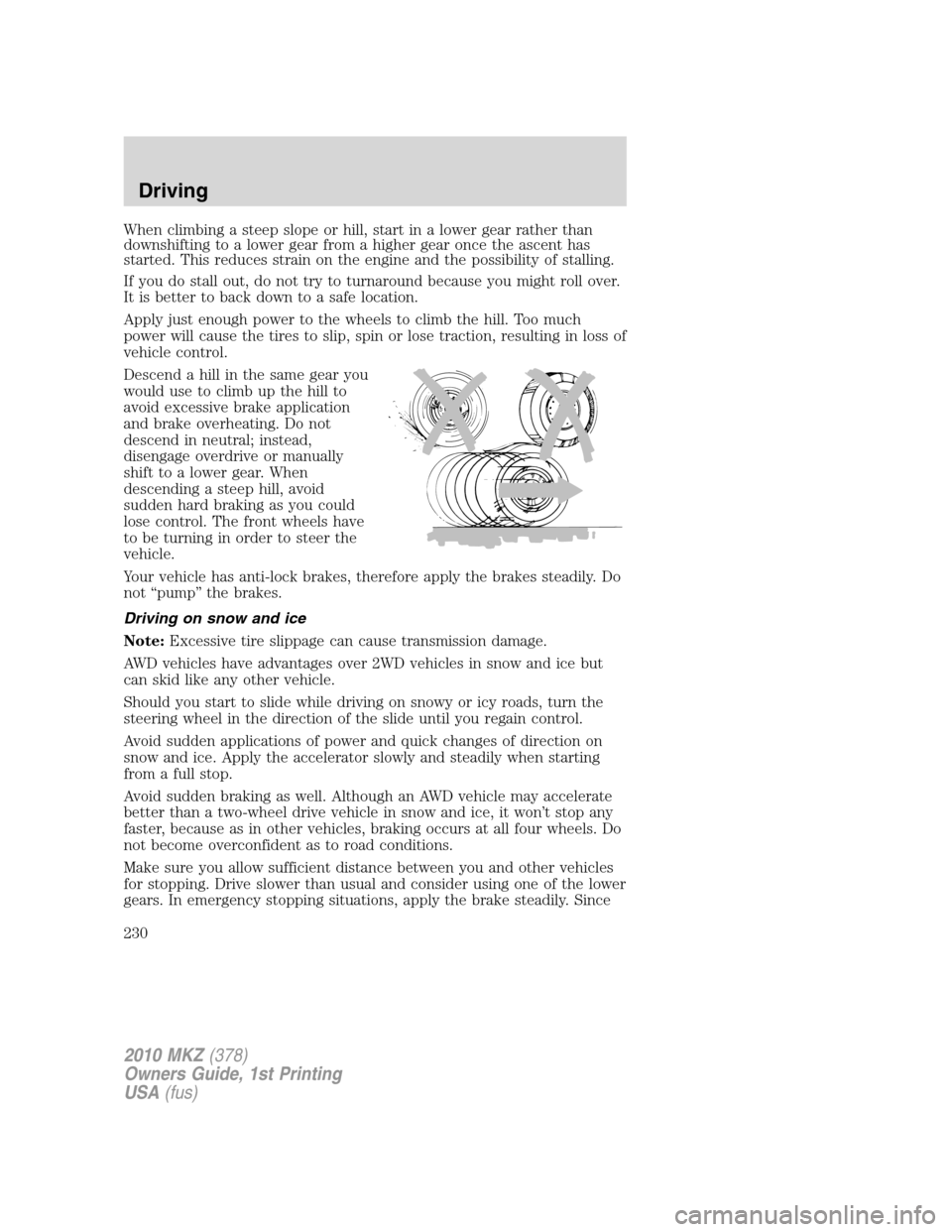
When climbing a steep slope or hill, start in a lower gear rather than
downshifting to a lower gear from a higher gear once the ascent has
started. This reduces strain on the engine and the possibility of stalling.
If you do stall out, do not try to turnaround because you might roll over.
It is better to back down to a safe location.
Apply just enough power to the wheels to climb the hill. Too much
power will cause the tires to slip, spin or lose traction, resulting in loss of
vehicle control.
Descend a hill in the same gear you
would use to climb up the hill to
avoid excessive brake application
and brake overheating. Do not
descend in neutral; instead,
disengage overdrive or manually
shift to a lower gear. When
descending a steep hill, avoid
sudden hard braking as you could
lose control. The front wheels have
to be turning in order to steer the
vehicle.
Your vehicle has anti-lock brakes, therefore apply the brakes steadily. Do
not “pump” the brakes.
Driving on snow and ice
Note:Excessive tire slippage can cause transmission damage.
AWD vehicles have advantages over 2WD vehicles in snow and ice but
can skid like any other vehicle.
Should you start to slide while driving on snowy or icy roads, turn the
steering wheel in the direction of the slide until you regain control.
Avoid sudden applications of power and quick changes of direction on
snow and ice. Apply the accelerator slowly and steadily when starting
from a full stop.
Avoid sudden braking as well. Although an AWD vehicle may accelerate
better than a two-wheel drive vehicle in snow and ice, it won’t stop any
faster, because as in other vehicles, braking occurs at all four wheels. Do
not become overconfident as to road conditions.
Make sure you allow sufficient distance between you and other vehicles
for stopping. Drive slower than usual and consider using one of the lower
gears. In emergency stopping situations, apply the brake steadily. Since
2010 MKZ(378)
Owners Guide, 1st Printing
USA(fus)
Driving
230